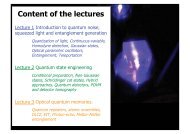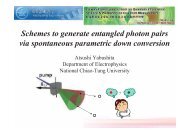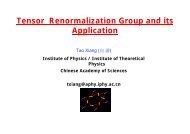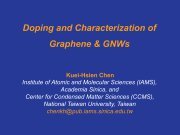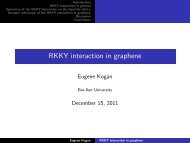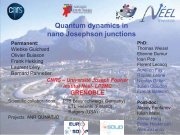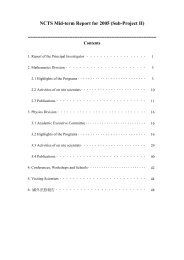Optical phonon properties, Fano interference and charged-phonon ...
Optical phonon properties, Fano interference and charged-phonon ...
Optical phonon properties, Fano interference and charged-phonon ...
Create successful ePaper yourself
Turn your PDF publications into a flip-book with our unique Google optimized e-Paper software.
1° Workshop on Nanoscience: Graphene, NCKU, Tainan City, Taiwan, 16 December 2011<br />
Emmanuele Cappelluti<br />
Instituto de Ciencia de Materiales de Madrid (ICMM) , CSIC, Madrid, Spain<br />
Institute of Complex Systems (ISC), CNR, Rome, Italy,<br />
Lara Benfatto<br />
ISC, CNR, Rome, Italy<br />
Alexey B. Kuzmenko<br />
Dept. Physics Uni. Geneve, Switzerl<strong>and</strong><br />
<strong>and</strong>: Z.Q. Li, C.H. Lui, T. Heinz (Columbia, NY, USA)
Outline<br />
motivations (limits of Raman spectroscopy)<br />
experimental measurements in bilayer graphene<br />
(intensity <strong>and</strong> <strong>Fano</strong> asymmetry of ph peak in optical conductivity)<br />
theoretical approach<br />
unified theory for <strong>phonon</strong> intensity (<strong>charged</strong> <strong>phonon</strong>)<br />
<strong>and</strong> <strong>Fano</strong> asymmetry<br />
tunable <strong>phonon</strong> switching effect<br />
multilayer graphenes<br />
conclusions
Probing interactions (<strong>and</strong> characterization) in graphenes<br />
electronic states<br />
ARPES<br />
- dispersion anomalies<br />
- renormalization<br />
- linewidth<br />
A Bostwick et al., NJP 9, 385 (2007)<br />
DC Elias et al., Nat Phys 7, 701 (2011)
Probing interactions (<strong>and</strong> characterization) in graphenes<br />
optical conductivity<br />
electronic states<br />
ZQ Li et al., Nat. Phys. 4, 532 (2008)<br />
- doping dependence<br />
- electronic interb<strong>and</strong> features<br />
- possible to extract b<strong>and</strong>gap Δ<br />
KF Mak et al, PRL 102, 256405 (2009)
Probing interactions (<strong>and</strong> characterization) in graphenes<br />
optical transitions<br />
lattice dynamics<br />
single layer<br />
in-plane<br />
in-plane<br />
out-of-plane <br />
E 2g (G)<br />
bilayer<br />
E g<br />
Raman<br />
E u<br />
IR
Raman spectroscopy<br />
<strong>phonon</strong> intensity<br />
C Casiraghi, PRB 80, 233407 (2009)<br />
I Calizo et al, JAP 106, 043509 (2009)<br />
difficult access to absolute <strong>phonon</strong> intensity<br />
relative intensity between different peaks instead used
Raman spectroscopy<br />
focus on:<br />
ph. frequency<br />
ph. linewidth<br />
J Yan et al, PRL 98, 166802 (2007)
Raman spectroscopy<br />
- not only characterization, also fundamental physics<br />
doping dependence<br />
of <strong>phonon</strong> frequency <strong>and</strong> linewidth:<br />
evidence of nonadiabatic<br />
breakdown of Born-Oppenheimer<br />
S Pisana et al, Nat Mat 6, 198 (2007)
Raman spectroscopy<br />
investigation tools:<br />
peak frequency<br />
peak linewidth<br />
relative (non absolute) peak intensity<br />
but<br />
no modulation of intensity<br />
no asymmetric peak lineshape<br />
J Yan et al, PRL 98, 166802 (2007)
IR <strong>phonon</strong> spectroscopy<br />
suitable tool???
IR <strong>phonon</strong> spectroscopy<br />
IR <strong>phonon</strong> peak best resolved in ionic systems<br />
-Z +Z<br />
Z: dipole effective charge<br />
(related to oscillator strength S, f)<br />
ex. Na + Cl - → Z = 1<br />
VG Baonza, SSC 130, 383 (2004)<br />
W'=<br />
integrated area<br />
∫<br />
[ ]<br />
dω σ'(ω) − σ' BG<br />
W' ∝ Z 2
IR <strong>phonon</strong> spectroscopy<br />
bilayer graphene<br />
one allowed in-plane IR mode: antisymmetric (A) E u<br />
homo-atomic compound<br />
first approximation: all the C atoms equal<br />
charge equally distributed<br />
no net dipole<br />
q q<br />
no IR activity<br />
q<br />
q
IR <strong>phonon</strong> spectroscopy<br />
taking into account the slight difference<br />
between atomic sites<br />
small charge disproportion<br />
finite dipole Z ≈ (q 1 -q 2 )<br />
q 1<br />
q 2<br />
however<br />
q 1 , q 2 < n<br />
limited by the total amount<br />
of doped charge n<br />
Z ≈ 10 -3<br />
(static dipole)<br />
q 2<br />
q 1<br />
no hope, thus..... but.....
Exp. results: Geneve group<br />
tunable <strong>phonon</strong><br />
peak intensity<br />
W’ (integrated area)<br />
Z ∝<br />
W'<br />
AB Kuzmenko et al, PRL 103, 116804 (2009)<br />
effective Born charge: Z max ~ 1.2!! huge!<br />
as large as 1 electron over N=4 (sp 3 ) !!
Exp. results: Geneve group<br />
tunable <strong>phonon</strong><br />
peak intensity<br />
neutrality point (NP) n=0<br />
also problem: negative peak area…<br />
Z not defined…?<br />
AB Kuzmenko et al, PRL 103, 116804 (2009)
Negative peak: <strong>Fano</strong> effect <strong>and</strong> quantum <strong>interference</strong><br />
arising from quantum <strong>interference</strong> (coupling)<br />
between a discrete state (<strong>phonon</strong>) with continuum spectrum (electronic)<br />
A=A BG<br />
+A' q2 -1-2qz<br />
q 2 ( z 2 +1) z=ω -ω 0<br />
Γ<br />
q =<br />
asymmetry<br />
<strong>Fano</strong> parameter<br />
non coupled <strong>phonon</strong><br />
weakly coupled<br />
strongly coupled<br />
symmetric lineshape<br />
|q| ≈ ∞<br />
asymmetric lineshape<br />
|q| ≈ 1<br />
negative peak<br />
|q| ≈ 0
Exp. results: Geneve group<br />
four independent parameter fit<br />
σ'(ω) − σ' BG<br />
(ω) = ω 2<br />
p<br />
4πΓ<br />
⎡<br />
z= ω -ω ⎤<br />
0<br />
⎣<br />
⎢<br />
Γ ⎦<br />
⎥<br />
q 2 -1-2qz<br />
q 2 z 2 +1<br />
( )<br />
ω p : related to intensity<br />
q : <strong>Fano</strong> asymmetry<br />
ω 0 : <strong>phonon</strong> frequency<br />
Γ : <strong>phonon</strong> linewidth<br />
W'= ω 2<br />
⎛<br />
p<br />
⎜<br />
8 1 − 1 ⎝ q 2<br />
⎞<br />
⎟<br />
⎠<br />
W= ω 2<br />
p<br />
8<br />
“bare” intensity (in the absence of <strong>Fano</strong>)<br />
AB Kuzmenko et al, PRL 103, 116804 (2009)
Exp. results: Geneve group<br />
<strong>phonon</strong> softening with doping:<br />
ok with LDA <strong>and</strong> TB theory<br />
E g (S) mode<br />
E u (A) mode<br />
T Ando, JPSJ 76, 104711 (2007)<br />
AB Kuzmenko et al, PRL 103, 116804 (2009)
Exp. results: Geneve group<br />
<strong>phonon</strong> linewidth: strong<br />
increase at NP: why??<br />
E u (A) mode?<br />
T Ando, JPSJ 76, 104711 (2007)<br />
AB Kuzmenko et al, PRL 103, 116804 (2009)
Exp. results: Geneve group<br />
linear dependence of bare<br />
intensity with doping:<br />
where from? why so huge Z?<br />
NB: tight-binding<br />
calculations<br />
AB Kuzmenko et al, PRL 103, 116804 (2009)
Exp. results: Geneve group<br />
linear dependence of bare<br />
intensity with doping:<br />
where from? why so huge Z?<br />
<strong>Fano</strong> asymmetry: where from?<br />
related to el. optical background?<br />
points out finite intensity at n=0…!<br />
AB Kuzmenko et al, PRL 103, 116804 (2009)
Charge-<strong>phonon</strong> effect<br />
doped insulators: organic <strong>and</strong> C 60 systems<br />
K x C 60<br />
huge intensity increase<br />
of selected IR modes<br />
upon electron doping x<br />
doping<br />
SC Erwin, in Backminsterfullerenes (1993)<br />
K-J Fu et al, PRB 46, 1937 (1992)
Charge-<strong>phonon</strong> effect<br />
σ el<br />
(ω) = −iωχ(ω)<br />
χ: el. polarizability (interb<strong>and</strong> transitions)<br />
χ(ω) =<br />
electronical background<br />
of optical conductivity<br />
direct light-<strong>phonon</strong> coupling<br />
but these no polar materials:....
Charge-<strong>phonon</strong> effect<br />
σ el<br />
(ω) = −iωχ(ω)<br />
χ: el. polarizability (interb<strong>and</strong> transitions)<br />
χ(ω) =<br />
electronical background<br />
of optical conductivity<br />
direct light-<strong>phonon</strong> coupling<br />
but these no polar materials:....<br />
no intrinsic dipole<br />
further channels to be considered
Rice (Michael) theory<br />
electronic polarizability provides finite IR intensity to<br />
<strong>phonon</strong> modes allowed but otherwise not active<br />
σ el<br />
(ω) = −iωχ(ω)<br />
χ: el. polarizability (interb<strong>and</strong> transitions)<br />
χ(ω) =<br />
irreducible diagrams<br />
electronical background<br />
of optical conductivity<br />
<strong>phonon</strong> mediated contribution<br />
giving rise to resonance at <strong>phonon</strong> energy<br />
no <strong>phonon</strong> resonance
Rice (Michael) theory<br />
fundamental ingredients:<br />
σ tot<br />
(ω) = −iω[ χ(ω) + λ ν<br />
xχ(ω)χ(ω)D ph<br />
(ω)]<br />
<strong>phonon</strong> resonance
Rice (Michael) theory<br />
fundamental ingredients:<br />
current/<br />
electron-<strong>phonon</strong><br />
response function<br />
σ tot<br />
(ω) = −iω[ χ(ω) + λ ν<br />
xχ(ω)χ(ω)D ph<br />
(ω)]<br />
intensity ruled by the current/electron-<strong>phonon</strong> response function
Rice theory in bilayer graphene<br />
χ: real function (α doping) tuning the <strong>phonon</strong> intensity
Rice theory in bilayer graphene<br />
χ: real function (α doping) tuning the <strong>phonon</strong> intensity<br />
Rice theory: in its original application: semiconductors<br />
effective theory:<br />
interesting peculiarities of bilayer graphene:<br />
zero gap semiconductor:<br />
low energy interb<strong>and</strong> transitions<br />
<strong>Fano</strong> asymmetry<br />
χ: complex quantity<br />
tunable <strong>charged</strong>-<strong>phonon</strong> effects controlled by external<br />
voltage biases (doping <strong>and</strong> gap)
Microscopic Rice theory in bilayer graphene<br />
three different response functions:<br />
χ jj (el.background)<br />
χ AA (ph. self-energy)<br />
χ jA (<strong>charged</strong>-<strong>phonon</strong> effect)<br />
we can compute microscopically each of them
<strong>Fano</strong>-Rice theory in bilayer graphene<br />
interb<strong>and</strong> transitions at low energy:<br />
D AA<br />
(ω) =<br />
χ jA = Reχ jA +iImχ jA<br />
1<br />
ω − ω A<br />
+ iΓ A<br />
σ' ep<br />
(ω) = 2 [ χ' (ω ) ] 2<br />
jA A<br />
ω ≈ωA<br />
ω A<br />
Γ A<br />
χ jA complex quantity!!!<br />
(in gapped systems: Imχ jA = 0)<br />
q 2 A<br />
−1 + 2zq A q A<br />
= − χ' (ω ) jA A<br />
q 2 A<br />
(1 + z 2 )<br />
χ" jA<br />
(ω A<br />
)<br />
<strong>Fano</strong> formula!<br />
<strong>Fano</strong> <strong>and</strong> <strong>charged</strong>-<strong>phonon</strong> effects same origin!<br />
it permits a microscopical identification
Peak parameters in <strong>Fano</strong> systems<br />
<strong>Fano</strong> fit<br />
σ' ep<br />
(ω)<br />
ω ≈ωA<br />
= 2W A<br />
πΓ A<br />
q A 2 −1 + 2zq A<br />
q A 2 (1 + z 2 )<br />
W A<br />
= π [ χ' (ω ) ] 2<br />
jA A<br />
ω A<br />
ω-integrated area<br />
W' A<br />
=<br />
{[ ] 2 − [ χ" jA<br />
(ω A<br />
)] 2<br />
}<br />
π χ' jA<br />
(ω A<br />
)<br />
ω A<br />
|q A | ≈ 0 (Reχ jA =0) ⇒ negative peak but W A =0<br />
not good<br />
|q A | ≈ 1 (Reχ jA = Imχ jA ) ⇒ asymmetric peak but W’ A =0 not good<br />
p A<br />
=<br />
{[ ] 2 + [ χ" jA<br />
(ω A<br />
)] 2<br />
}<br />
π χ' jA<br />
(ω A<br />
)<br />
ω A<br />
<strong>phonon</strong><br />
strength
Theory vs. experiments<br />
n c = αV g<br />
Au contacts<br />
modelling field effect:<br />
gating induces doping<br />
but also vertical electric field E z<br />
(inducing gap)<br />
SiO 2<br />
Si<br />
GRAPHENE<br />
step by step analysis:<br />
(1) we first consider only the doping effects induced by gate<br />
(2) we later consider only the electric effects induced by gate
Phonon intensity in bilayer graphene<br />
(1) gating induces doping but not E z<br />
in this case no low-energy transitions between 2 <strong>and</strong> 3<br />
system like a gapped semiconductor<br />
Imχ = 0 no <strong>Fano</strong> effect<br />
4<br />
γ<br />
1<br />
3<br />
2<br />
doping depedence of ω-integrated area W’<br />
perfectly reproduced<br />
what about W A ?<br />
negative area?<br />
E Cappelluti et al, PRB 82, 041402 (2010)
Exp. results: Berkeley group<br />
double-gated device<br />
possible tuning doping <strong>and</strong><br />
Δ in independent way<br />
n = 0<br />
n = 0 <strong>and</strong> Δ ≠ 0: negative peak like us<br />
<strong>Fano</strong> effect as a function of Δ<br />
they attribute origin<br />
of negative peak at n = 0<br />
to E g (S) (Raman-active) mode<br />
(S allowed by symmetry in IR when Δ ≠ 0)<br />
T-Ta Tang et al, Nat Nanotechn 5, 32 (2010)
Different <strong>phonon</strong> channels in optical conductivity<br />
gating induces z-axis asymmetry E z<br />
two main IR channels present<br />
Δ > 0<br />
E g (S) mode also IR active!<br />
probes D AA ph. propagator<br />
probes D SS ph. propagator<br />
relative “intensity” ruled by p A <strong>and</strong> p S<br />
total spectra dependent on the relative dominance<br />
of one channel vs. the other one
<strong>Optical</strong> channels <strong>and</strong> <strong>phonon</strong> switching in optical conductivity<br />
Δ-μ phase diagram<br />
Berkeley<br />
E u -A <strong>and</strong> E g -S modes<br />
dominant in different regions<br />
of phase diagram:<br />
possible switching of intensity<br />
from one mode to other one<br />
Geneve<br />
E Cappelluti et al, PRB 82, 041402 (2010)
Phonon switching in optical conductivity<br />
E u (A)<br />
Geneve group<br />
E g (S) <br />
E u (A)<br />
E Cappelluti et al, PRB 82, 041402 (2010)<br />
AB Kuzmenko et al, PRL 103, 116804 (2009)<br />
experimental integrated area <strong>and</strong> <strong>Fano</strong> asymmetry<br />
interpolates <strong>and</strong> switches from A to S mode
Multilayer graphenes<br />
N=3,..,6 layer with different stacking order on substrate (no gating)<br />
intensity <strong>and</strong> <strong>Fano</strong> asymmetry strong depending on N-layer <strong>and</strong> stacking order<br />
ABA <strong>and</strong> ABC deeply<br />
different<br />
stacking revealed<br />
ZQ Li, CH Lui, E Cappelluti, L Benfatto, KF Mak, L Carr, J Shan, TF Heinz, arXiv:1109.6367
Multilayer graphenes<br />
N=3,..,6 layer with different stacking order on substrate (no gating)<br />
intensity <strong>and</strong> <strong>Fano</strong> asymmetry strong depending on N-layer <strong>and</strong> stacking order<br />
ABA <strong>and</strong> ABC deeply<br />
different<br />
stacking revealed<br />
ZQ Li, CH Lui, E Cappelluti, L Benfatto, KF Mak, L Carr, J Shan, TF Heinz, arXiv:1109.6367
Trilayer gated graphenes <strong>and</strong> stacking order<br />
ABA <strong>and</strong> ABC deeply<br />
different<br />
stacking revealed<br />
<strong>phonon</strong> intensity<br />
<strong>and</strong> <strong>phonon</strong> frequency<br />
strongly doping dependent<br />
in ABC but not in ABA<br />
good agreement<br />
with theory<br />
CH Lui et al, preprint (2011)
Trilayer gated graphenes <strong>and</strong> stacking order<br />
fundamental ingredient: electronic b<strong>and</strong> structure<br />
reminder: <strong>phonon</strong> activity is triggered by electronic particle-hole excitations<br />
upon doping, el. transitions<br />
at ω = √2 γ 1 ≈ 0.55 eV in ABA,<br />
at ω ≤ γ 1 ≈ 0.39 eV in ABC<br />
CH Lui et al, submitted to PRL (2011)<br />
ABC closer to ω 0 ≈ 0.2 eV<br />
<strong>phonon</strong> activity amplified
Raman spectroscopy in bilayer graphene<br />
remarkable features:<br />
|q| ≈ ∞ no <strong>Fano</strong> asymmetry !!! (in IR S mode had q ≈ 0)<br />
intensity does not depend on doping !!!<br />
unlike<br />
IR probes!<br />
why?<br />
J Yan et al,<br />
PRL 98, 166802 (2007)<br />
C Casiraghi, PRB 80, 233407 (2009)
<strong>Fano</strong>-Rice theory for Raman spectroscopy<br />
effective mass approximation<br />
ˆ γ xy<br />
∝<br />
d ˆ H k<br />
dk x<br />
dk y<br />
Raman vertex<br />
χ γγ<br />
(τ) = − T τ<br />
γ(τ)γ<br />
electronic<br />
Raman background<br />
Rice theory<br />
Raman active<br />
S mode<br />
χ tot γγ<br />
(ω) = χ irr γγ<br />
(ω) + χ irr γS<br />
(ω)D SS<br />
(ω)χ irr Sγ<br />
(ω)
<strong>Fano</strong>-Rice theory for Raman spectroscopy<br />
IR Raman<br />
Reχ jA ~ const.<br />
Reχ γS ~ E C<br />
E C<br />
Imχ jA ~ const.<br />
Imχ γS ~ const.<br />
Reχ γS scaling with UV dispersion cut-off E c<br />
Reχ γS >> Imχ γS <br />
W’ S ≈ W S ∝ E c<br />
2<br />
weakly dependent on b<strong>and</strong>-structure<br />
details (doping, Δ)<br />
q S<br />
= − Reχ γS (ω A )<br />
Imχ γS<br />
(ω A<br />
) ≈ − ∞<br />
no <strong>Fano</strong> profile
Conclusions<br />
source of microscopic IR <strong>phonon</strong> intensity<br />
unified theory of IR intensity <strong>and</strong> <strong>Fano</strong> profile<br />
more information encoded in <strong>phonon</strong> intensity <strong>and</strong> <strong>Fano</strong> factor<br />
<strong>phonon</strong> mode switching predicted (<strong>and</strong> observed)<br />
differences between IR <strong>and</strong> Raman spectroscopy accounted for<br />
alternative <strong>and</strong> powerful tool to characterize ML graphenes





